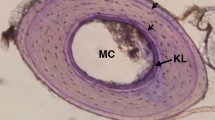Abstract
To examine whether different thermal environments have induced a change in thermal characteristics, we have conducted a between-population comparison on broad geographic patterns of preferred body temperature and critical thermal maximum in a giant spiny-frog Paa spinosa. We found a bimodal pattern of preferred body temperature during the day, with high preferred body temperature during the inactive diurnal period and low temperature during the active nocturnal period. There were significant differences among six populations of P. spinosa in preferred body temperatures, which decreased along a south to north gradient. Unlike preferred body temperatures, critical thermal maximum did not differ between frogs from the six localities. Although not all characteristics of thermal physiology in P. spinosa underwent parallel changes between the populations, the shift of preferred body temperatures suggests that the features of thermal physiology in the frog may change along a latitudinal gradient in response to different thermal environments.



Similar content being viewed by others
References
Andrews RM (1998) Geographic variation in field body temperature of Sceloporus lizards. J Therm Biol 23:329–334
Angilletta MJ, Werner YL (1998) Australian geckos do not display diel variation in thermoregulatory behavior. Copeia 1998:736–742
Bauwens D, Garland T, Castilla AM, Van Damme R (1995) Evolution of sprint speed in Lacertid lizards: morphological, physiological, and behavioral covariation. Evolution 49:848–863
Bauwens D, Hertz PE, Castilla AM (1996) Thermoregulation in a Lacertid lizard: the relative contributions of distinct behavioral mechanisms. Ecology 77:1818–1830
Brattstrom BH (1959) The role of evaporative cooling as a thermoregulatory device in tropical amphibians. Yr Bk Am Philos Soc 1959:225–226
Brattstrom BH (1962) Thermal control of aggregation behavior in tadpoles. Herpetologica 18:38–46
Brattstrom BH (1963) A preliminary review of the thermal requirements of amphibians. Ecology 44:238–255
Brattstrom BH (1968) Thermal acclimation in anuran amphibians as a function of latitude and altitude. Comp Biochem Physiol 24:93–111
Brattstrom BH (1979) Amphibian temperature regulation studies in the field and in the laboratory. Am Zool 19:345–356
Buttemer WA (1990) Effect of temperature on the evaporative water loss of the Australia tree frogs Litoria caerulea and Litoria chloris. Physiol Zool 63:1043–1057
Castilla AM, Van DR, Bauwens D (1999) Field body temperatures, mechanisms of thermoregulation and evolution of thermal characteristics in lacertid lizards. Nat Croat 8:253–274
Dawson WR (1975) On the physiological significance of the preferred body temperatures of reptiles. In: Gates DM, Schmerl RB (eds) Per-spectives of biophysical ecology. Springer, New York, pp 443–473
Du WG (2006) Preferred body temperature and thermal tolerance of the northern grass lizard Takydromus septentrionalis form localities with different longitudes. Acta Zool Sin 52:478–482
Du WG, Yan SJ, Ji X (2000) Selected body temperature, thermal tolerance and thermal dependence of food assimilation and locomotor performance in adult blue-tailed skinks Eumeces elegans. J Therm Biol 25:197–202
Ellis DJ, Firth BT, Belan I (2007) Circadian rhythms of locomotor activity and temperature selection in sleepy lizards, Tiliqua rugosa. J Comp Physiol A 193:695–701
Firth BT, Belan I (1998) Daily and seasonal rhythms in selected body temperatures in the Australian lizard Tiliqua rugosa (Scincidae): Weld and laboratory observations. Physiol Zool 71:303–311
Grant BC, Dunham AE (1990) Elevational covariation in environmental constraints and life histories of the desert lizard Sceloporus merriami. Ecology 71:1765–1776
Hertz PE, Huey RB, Stevenson RD (1993) Evaluating temperature regulation by field-active ectotherms: the fallacy of the inappropriate question. Am Nat 142:796–818
Huey RB (1982) Temperature, physiology, and the ecology of reptiles. In: Gans C, Pough FH (eds) Biology of the Reptilia, vol 12. Academic Press, London, pp 25–91
Huey RB, Bennett AE (1987) Phylogenetic studies of coadaptation: preferred temperatures versus optimal performance temperatures of lizards. Evolution 41:1098–1115
Huey RB, Bennett AE (1990) Physiological adjustments to fluctuating thermal environments: an ecological and evolutionary perspective. In: Morimotos A, Tissiere A, Georgopoulus C (eds) Stress proteins in biology and medicine. Cold Spring Harbor Laboratory Press, Cold Spring Harbor, New York, pp 37–59
Huey RB, Kingsolver JG (1989) Evolution of thermal sensitivity of ectotherm performance. Trends Ecol Evol 4:131–135
Huey RB, Slatkin M (1976) Costs and benefits of lizard thermoregulation. Q Rev Biol 51:363–384
Hutchison VH, Dupré RK (1992) Thermoregulation. In: Feder ME, Burggren WW (eds) Physiology of amphibians. University of Chicago Press, Chicago, pp 207–215
Ji X, Du WG, Sun PY (1996) Body temperature, thermal tolerance and influence of temperature on sprint speed and food assimilation in adult grass lizards Takydromus septentrionalis. J Therm Biol 21:155–161
Kingsolver JG, Watt WB (1983) Thermoregulatory strategies in Colias butterflies: thermal stress and the limits to adaptation in temporally variable environments. Am Nat 121:32–55
Licht P (1968) Response of the thermal preferendum and heat resistance to thermal acclimation under different photoperiods in the lizard Anolis carolinensis. Am Midl Nat 79:149–158
Lillywhite HB (1970) Behavioral temperature regulation in the bullfrog, Rana catesbeiana. Copeia 1970:158–168
Lillywhite HB (1971) Thermal modulation of the cutaneous mucus discharge as a determinant of evaporative water loss in the frog, Rana temporaria. Z Vergl Physiol 73:84–104
Lillywhite HB (1975) Physiological correlates of basking in amphibians. Comp Biochem Physiol 52A:323–330
Lima SL, Rattenborg NC, Lesku JA, Amlaner CJ (2005) Sleeping under the risk of predation. Anim Behav 70:723–736
Liu HL (2004) The advancement of biological research in amphibian culture in China. J Dalian Fish Univ 19:120–126
Marden JH, Kramer MG, Frisch J (1996) Age-related variation in body temperature, thermoregulation and activity in a thermally polymorphic dragonfly. J Exp Biol 199:529–535
Navas CA, Gomes FR, Carvalho JE (2008) Thermal relationships and exercise physiology in anuran amphibians: Integration and evolutionary implications. Comp Biochem Physiol Part A 151:344–362
Precht H, Christophersen J, Hensel H, Larcher W (1973) Temperature and life. Springer, Berlin
Refinetti R, Menaker M (1992) the circadian rhythm of temperature. Physiol Behav 51:613–637
Refinetti R, Susalka SJ (1997) Circadian rhythm of temperature selection in a nocturnal lizard. Physiol Behav 62:331–336
Regal PJ (1967) Voluntary hypothermia in reptiles. Science 155:1551–1553
Rismiller PD, Heldmaier G (1988) How photoperiod in Xuences body temperature selection in the lizard Lacerta viridis. Oecologia 75:125–131
Rock J, Andrews RM, Cree A (2000) Effects of reproductive condition, season, and site on selected temperatures of a viviparous gecko. Physiol Biochem Zool 73:344–355
Sepúlveda M, Vidal MA, Fariña JM, Sabat P (2008) Seasonal and geographic variation in thermal biology of the lizard Microlophus atacamensis (Squamata: Tropiduridae). J Therm Biol 33:141–148
Tracey CR, Christian KA (2005) Preferred temperature correlates with evaporative water loss in hylid frogs from Northern Australia. Physiol Biochem Zool 78:839–846
Tracy CR (1975) Water and energy relations of terrestrial amphibians: Insights from mechanistic modeling. In: Gates DM, Schmerl RB (eds) Perspectives of biophysical ecology. Springer, New York, pp 325–346
Van Berkum FH (1986) Evolutionary patterns of the thermal sensitivity of sprint speed in Anolis lizards. Evolution 40:594–604
Yang J, Sun YY, An H, Ji X (2008) Northern grass lizards (Takydromus septentrionalis) from different populations do not differ in thermal preference and thermal tolerance when acclimated under identical thermal conditions. J Comp Physiol B 178:343–349
Yu BG, Ye RH, Zheng RQ, Zhou Y, Liu CT, Chen X (2008) A preliminary study on the ethogram and activity rhythm of capative Paa spinosa during breeding period. Acta Ecol Sin 28:6371–6378
Zhao EM (1998) China red data book of endangered animals—amphibia. Science Press, Beijing
Acknowledgments
We are grateful to Baogen Yu for his assistance in the laboratory and Weiguo Du for his comments. We also thank two anonymous reviewers for their constructive comments on a previous version of this manuscript. This research was supported by the Science Technology Commission of Zhejiang Province of China (No. 2006C22031).
Author information
Authors and Affiliations
Corresponding author
Rights and permissions
About this article
Cite this article
Zheng, RQ., Liu, CT. Giant spiny-frog (Paa spinosa) from different populations differ in thermal preference but not in thermal tolerance. Aquat Ecol 44, 723–729 (2010). https://doi.org/10.1007/s10452-009-9310-3
Received:
Accepted:
Published:
Issue Date:
DOI: https://doi.org/10.1007/s10452-009-9310-3




